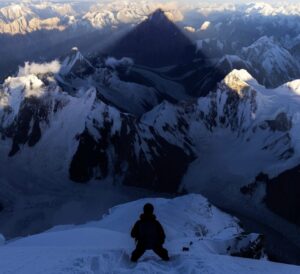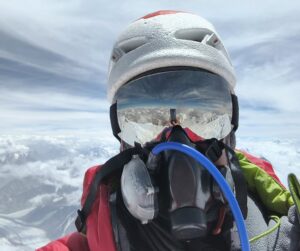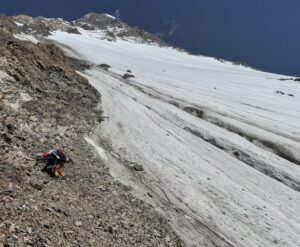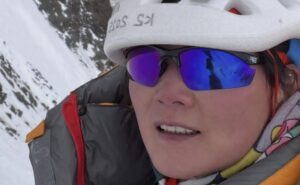French alpinist Benoit Chamoux holds the record for the fastest ascent of K2 without bottled oxygen. On July 5, 1986, just a couple of weeks after soloing Broad Peak, Chamoux ascended 8,611m K2 via the Abruzzi Spur in 23 hours from Base Camp to the summit. He climbed solo.
But with new records reported this season, does Chamoux still wear K2’s speed record crown?
The challenge
On July 27, 2022, two Nepali Sherpas announced that they would attempt a speed ascent on K2. They named their challenge “Speed Breaker”. The route would be the Abruzzi Spur.

Lakpa Dendi Sherpa and Mingma David Sherpa, ready for their speed challenge. Photo: Mingma David Sherpa
Mingma David Sherpa and Lakpa Dendi Sherpa released a poster, in which one challenged the other. Each shared their trackers on social media so that people could follow their ascent in real-time.
“This will be the ultimate test of human physiology,” Lakpa Dendi told the Everest Chronicle. “We definitely want to break the record, but this will also test our physical and mountaineering skills. If we succeed, it will also be a world record speed climb of the Savage Mountain.”

Chhiring Sherpa. Photo: Mingma G
More climbers enter the race
Shortly after, another agency announced that one of their Sherpas, Chhiring Sherpa, was also aiming to set a speed record. A few hours later, Mingma G reported that French climber Benjamin Vedrines would also make a rapid ascent of K2, though Vedrines had not confirmed this.
The task was not going to be easy. There is constant rockfall on the route, and every time one ascends, life is at stake. Going through the Bottleneck at more than 8,000m is like playing Russian roulette because of the constant threat of the serac that hangs over the way.

Benjamin Vedrines. Photo: Benjamin Vedrines
Soon after, the press picked up the story, and Benoit Chamoux was brought up as the person to beat. What was not discussed enough was whether any of the challengers were going to ascend with or without supplemental oxygen.
Mysterious Vedrines
According to information not yet corroborated by the French climber, Vedrines recently made a very fast ascent of Broad Peak. He summited in seven hours and 28 minutes, without supplemental oxygen. If confirmed, his time shatters the previous speed record.
Based on this information, it seems likely that Vedrines would also attempt K2 without bottled O2.

The Abruzzi Spur on K2. Photo: Pakistan Tourist Board
What we know
By July 28, we knew the times for some of the climbers. Chhiring Sherpa had summited quickest, going from Base Camp to summit in 12 hours 20 minutes, and 23 seconds. Chhiring started from Base Camp on July 27 at 4:30 pm and reached the summit on July 28 at 4:50 am.
Mingma David Sherpa topped out in 14 hours and 22 minutes. We don’t know Lakpa Dendi’s time exactly because his tracker stopped working at Camp 2, and we still don’t know anything about Benjamin Vedrines’ time.
A new speed record?
Chhiring never mentioned Chamoux and had no intention of ignoring the Frenchman’s 1986 climb. However, the word “record” soon spread in the press and on social networks, despite no information regarding the use of O2. The Nepal National Mountain Guide Association (NNMGA), soon claimed that Chhiring’s 12-hour and 20-minute ascent was an “all-time speed climbing record.”

The upper section and the summit of K2. Photo: Mike Horn
This implied that Chhiring Sherpa (and incidentally also Mingma David Sherpa) had bested the late Benoit Chamoux’s speed record. But the comparison was not justified without knowing who did, or did not, use oxygen.
Chhiring Sherpa answers
Chhiring Sherpa confirmed to ExplorersWeb that he used supplemental oxygen from 6,700m. Mingma David Sherpa likely also used O2 but has not confirmed this yet.
An ascent with bottled oxygen completely changes a climb. Therefore we have to place these new speed climbs in a different category from Chamoux’s effort.

Descending the traverse beneath K2’s infamous serac this season. Photo: Javier Beiza
It’s simple to differentiate. The fastest ascent of K2 without O2 remains Benoit Chamoux’s in 1986. The fastest ascent with O2 is by Chhiring Sherpa.
Putting everything in its proper context, all the climbers in this article have room for recognition, but let’s respect the late Chamoux’s legacy.

K2. Photo: Summit Karakoram
Benoit Chamoux
Benoit Chamoux is possibly the only person to have climbed three 8,000’ers, each within 24 hours of the other, without supplemental oxygen. He was a talented and strong climber. Chamoux was also the first to carry out height measurements of Mount Everest using satellites.

Benoit Chamoux measuring the height of Mount Everest. Photo: Benoit Chamoux
Kurt Diemberger called him “Benoit, the Fast”. Chamoux’s speed ascent on K2 came during a tragic summer season in 1986. Thirteen climbers died in a variety of circumstances. He climbed using the tracks of his teammates and the prepared route. His no-O2 speed ascent is well detailed in Jim Curran’s book, K2: Triumph and Tragedy.
Chamoux disappeared at age 34 near the summit of Kangchenjunga, on October 6, 1995.
Chhiring Sherpa
The powerful Chhiring Sherpa managed to climb K2 twice within a week. First, he guided his client to the summit on July 22, then he made his rapid ascent on July 28. He achieved a fantastic Base Camp-summit-Base Camp time of 20 hours and 18 minutes, with the use of supplemental O2.
Chhiring first summited Everest when he was 16 years old while working. Three years later, at the age of 19, he worked on K2 and also summited. As reader Chris Warner mentioned in a comment on a previous news story, Chhiring has also competed in Nepal’s national climbing championships and is a good skier.

Chhiring Sherpa. Photo: Pemba Sherpa/Imagine Nepal
Mingma David Sherpa
We should also mention Mingma David Sherpa, who achieved his fifth summit on K2. Like Chhiring, he climbed K2 twice this season, first guiding on July 22, and then during his speed ascent on July 28.
Mingma David Sherpa now holds the record for most K2 summits. He is currently the youngest person to have climbed all 14×8,000’ers and was among the summiters on the K2 winter team. Most of his climbs have been with bottled O2 because of his guiding duties.

Mingma David Sherpa. Photo: Mingma David Sherpa
Lakpa Dendi Sherpa
Lakpa Dendi Sherpa is best known for summiting Everest three times in 10 days in 2018. However, he has summited nine different 8,000’ers 29 times (most of them with O2 while working).

Lakpa Dendi Sherpa. Photo: Lakpa Dendi Sherpa
Benjamin Vedrines
Benjamin Vedrines is a French pro-alpinist and mountain guide from Briancon, France. He typically climbs without supplemental oxygen. His 7-hour, 28-minute ascent of Broad Peak, without O2 or a high-altitude porter, was an excellent 8,000m debut.
Despite his youth, he has a lot of experience. He was part of the group that achieved the first alpine-style winter climb of the Directtissima Harlin on the North of the Eiger. He also took on two other difficult north-facing routes, the Directe de l’Amitie in the Jorasses, and the Gogna-Cerutti, north of the Matterhorn. Last fall, with Charles Duboloz, he opened a difficult route on Chamlang (7,319m).
We await details of his K2 climb.

Benjamin Vedrines. Photo: Ulysse Lefebvre
Proper context
Supplemental oxygen obviously makes a huge difference to a climber’s speed. Without O2 above 8,500m, the average person ascends approximately 30m per hour. From 8,000m to around 8,500m, a climber begins to decelerate, but from 8,500m, the effect is much greater.
Before this zone, lower than 8,500m, climbers are considerably faster. They can climb at 50-60m per hour, and if the terrain is easy, 70-80m per hour. Even 100m per hour is not out of the question. But 30m per hour is typical for the last 150-200m on the highest 8,000’ers. If the terrain is more difficult, then this deceleration can happen lower down the mountain.

Climbing the lower part of the Cesen route, a steeper and more direct line than the Abruzzi Spur. Photo: Ralf Dujmovits
Climbing speed also depends on the weather, terrain, and if the route is already open. Therefore, comparing times doesn’t always make a lot of sense.
Let’s not forget that “the chronometer is not part of a mountaineer’s equipment,” as the late David Lama famously said.






